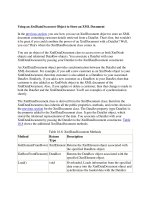Secured clone detection using witness head selection to avoid malicious nodes in WSN
Bạn đang xem bản rút gọn của tài liệu. Xem và tải ngay bản đầy đủ của tài liệu tại đây (1.13 MB, 6 trang )
ISSN:2249-5789
Nadiya N et al, International Journal of Computer Science & Communication Networks,Vol 7(3),46-51
Secured Clone Detection using Witness Head
Selection to Avoid Malicious Nodes in WSN
Nadiya N
M.Tech, DCN
Department of Telecommunication Engineering
Dr. AIT, Bangalore
Abstract—An energy-efficient location-aware clone attack
detection protocol is determined and generally deployed Wireless
Sensor Networks, which can certify great clone attack detection.
The ring structure helps energy-efficient data information,
forwarding along the path towards the witness nodes and the
sink node. The localization information of each sensor node
forward its private information to randomly selected witness
nodes which are present in a ring structure area to verify the
legitimacy of sensor nodes and to report detected clone attacks.
The RSA algorithm is used to secure data packets are transmit
from source node to sink node by powerful clone attack, which
can be eliminated by the malicious nodes. The proposed protocol
can achieve high clone detection probability using randomly
selected trustful witnesses and with larger network lifetime, by
effectively distributing the traffic load across the network.
Index Terms—Wireless Sensor Networks, Clone Detection
protocol, Energy-memory efficient, Network Lifetime, Secure
data
I. INTRODUCTION
Now a day’s world is changing dynamically and Wireless
Sensor Networks (WSN) has become an important part of
communication media, and it is used for a variety of
applications that are military, beginning of environment
monitoring, etc., [1], [2], [3]. A WSN generally consists of a
Base Station and several numbers of sensor nodes. Where
geographical areas observed by sensor nodes and later these
nodes gathers sensor data information. The base station is a
main for collecting information from sensor nodes throughout
wireless media hop by hop. Then base station send collected
data information to user through the internet. Therefore small
size and low price of wireless sensors are used to construct
large-scale sensor networks.
Sensors are usually not tamper-proof devices and are
deployed in location without monitoring and protection, which
makes them susceptible to different attacks [4], [5]. Due to the
low price of sensor duplication and deployment, attacks have
become one of the most critical security issues in WSNs. For
example, a malicious user may compromise some sensors and
take their private information. Clone attack is one of most
harmful attack is deployment WSN and also is great
challenging to determine clone. Clone attacks are defined as
the malicious user compromises the network sensor node by
IJCSCN | June-July 2017
Available
Prashanth C R
Professor
Department of Telecommunication Engineering
Dr. AIT, Bangalore
utilizing side channel attacking technique adventure the data
information on the node. After compromising the node, the
attacker exploits the confidential information, including secret
keys and transfers it on other clone nodes. Cloned sensor node
can be invested to capture the information of the network
region. The adversary can also add false information, or
manipulate the data information passing through cloned nodes.
To find efficient clone detection, let us consider a set of
sensor nodes that are selected from the network, which is
known as witnesses, with the help of the witness nodes and
witness headers to prove the legitimacy of the nodes in the
network. When any of the sensor nodes in the network want to
transmit data, it first sends the request to the witnesses for
legitimacy verification. Then private information of the source
sensor node i.e., identity and the location information are
shared with all neighbor sensor nodes, witnesses at the stage
of witness selection, and witness nodes will report a detected
attack to sink node. To achieve successful clone detection,
witness selection and legitimacy verification should perform
two requirements: 1) randomly selected witnesses; 2) At least
one of the witness nodes can successfully receive all the
verification messages for clone detection [6].
The first requirement is to make it difficult for malicious
users or attackers eavesdrop the communication between the
current source node and its witnesses so that the attacker
cannot make duplicate verification messages. The second
requirement is to make sure that at least any one of the
witnesses can verify the identity of the sensor nodes to find
whether there is a clone attack or not. To guarantee high clone
detection, [7], [8], [9], probability, i.e., the probability that
clone attacks can be successfully detected, it is critical and
challenging to these requirements in clone detection protocol
design.
In this design, the main aim is to detect clone attacks on
WSN and also to control the energy consumption and memory
storage of clone detection protocol. To achieve high clone
detection probability with random witness selection and for
making satisfactory network lifetime of WSNs, is determined
by using an Energy-efficient Ring based Clone Detection
(ERCD) protocol. This protocol is applicable to general
densely deployed multi-hop WSNs.
46
ISSN:2249-5789
Nadiya N et al, International Journal of Computer Science & Communication Networks,Vol 7(3),46-51
and efficient to detect replica location claims being used at
two different locations in the network.
Figure -1 ERCD Protocol design
The ERCD protocol consists of two stages: one is witness
selection and another one is legitimacy verification. In witness
selection, each source sensor node randomly mapping function
is employed to select its witnesses. In the legitimacy
verification, witness nodes send verification message along
with private information of the source sensor node to its
witness headers. The witnesses will successfully gain the
message and it will forward to its witness header for
verification. Upon receiving the messages from witness nodes,
the witness header compares the source verification messages
with pre-stored records. If the verification messages be
different as of pre-stored records, the clone attack is detected
and procedure is triggered as shown in figure-1. The Ron
Rivest, Adi Shamir, and Leonard Adleman (RSA) security
algorithm are proposed to find security issues in WSN.
II. LITERATURE SURVEY
The majority works that are done for clone detection protocols
[10], [11], [12], in WSN, Mumtaz Qabulio et al., [13]
proposed scheme which uses nodes physical location
information or any other complex computational intensive
algorithm; it is best suited for memory and computationally
constrained sensor nodes.
Clone detection protocol is classified into two different
categories, i.e., centralized and distributed clone detection
protocols. The centralized protocol is designed with the sink
or witnesses that are usually located in the center of each
region and store the private information of sensor nodes. The
source node sends its private information to the sink or
witnesses, in which a witness compares the private
information of source node with its pre-stored records then it
determines whether it’s a clone attack or not.
Richard Brooks et al., [14] proposed a Random key
predistribution seems particularly well suited on Wireless
Sensor Network for detecting cloning attacks. This protocol
compares all keys from Bloom filters is gather key data
message from all sensor nodes with a threshold value, and if
any key is greater than threshold values then that node is
considered as cloned attack and removed from the network.
Wibhada Naruephiphat et al., [15] design to achieve high
successful detecting replica rate with the small amount of
communication in Wireless Sensor Networks. The proposed
Area-Based Clustering Detection (ABCD) method is simple
IJCSCN | June-July 2017
Available
Usually, centralized clone [16] detection protocols have low
overhead and running complexity. However, the malicious
users can eavesdrop the transmission between the sink node
and sensors, therefore the security of sensor private
information may not be guaranteed. Whenever the sensor
nodes and the sink are close to each other, sensor nodes will
deplete their energy sooner than other nodes and dramatically
decreases its network lifetime.
In a distributed clone detection protocols, a set of
witnesses is selected to support every sensor. These sensors
transmit the data between the sink and sensors from being
eavesdropped by malicious users. Distributed clone detection
protocols consist of three different types for the selection of
witnesses, that are: i) deterministic selection, ii) random
selection and iii) semi-random selection. In the deterministic
witness selection, the same set of witnesses for all sensor
nodes are chosen based on clone detection protocols like
proposed Randomized Efficient and Distributed (RED)
protocol.
Mauro Conti et al., [17] proposed a RED protocol for the
detection of node replication attacks. In particular, it has
introduced the preliminary notion of ID-obliviousness and
area-obliviousness that convey a measure of the quality of the
node replicas detection protocol; that is, its resilience to a
smart adversary.
The distributed clone detection protocols with random
witness selection [6] similar to Line-Select Multicast (LSM)
protocols, which are closely related to this project which will
enhance the network security.
Yingpei Zeng et al., [18] to find replica-detection protocols
must be, Non-Deterministic and Fully Distributed (NDFD)
and fulfill three security requirements on witness selection.
Based on a random walk, Yingpei Zeng proposed two new
NDFD protocols that are Random Walk (RAWL) and Tableassisted Random Walk (TRAWL), fulfilling the requirements
while having only common communication and memory
overheads.
Mohammad Y Aalsalem et al., [19] proposed a Random
Walked (RAWL) starts with several random walks in a
network. RAWL is one of the witness nodes based distributed
techniques, witness nodes are randomly selected by starting
many random walks around the network. RAWL has gained
high security of witness nodes. The enhancement of RAWL
protocol is aiming to decrease the communication and
memory costs while keeping the detection probability high.
In random witnesses selection, each sensor is randomly
selected its witness so that it is difficult for malicious users to
get the information from witnesses. This scheme is difficult
for the source node to reach its witnesses because the
randomness of mapping function is increasing so that it makes
a challenge to achieve a high clone detection probability. To
47
ISSN:2249-5789
Nadiya N et al, International Journal of Computer Science & Communication Networks,Vol 7(3),46-51
ensure the clone detection probability, LSM lets all the nodes
in the route between source and witnesses, store the private
information of the source node, which leads to the high
requirement of data buffer and energy consumption. The clone
detection probability with low energy consumption and
necessary data buffer storage with random witness selection
approach is done successfully using random witness selection.
Another last distributed clone detection protocols are semirandom witness selection approach is adding the advantages of
both deterministic witness and random selection approaches
which are proposed as Parallel Multiple Probabilistic Cells (PMPC).
Ming Zhang et al., [20] proposed to achieve the high
replicas attack probability, considering little energy
consumption, and small memory overhead sensor networks
which are sensitive. This will enable to find replication attacks
using four replication detection protocols they are B-MEM,
BC-MEM, C-MEM, and CC-MEM.
Bo Zhu et al., [21] proposed two variants of the Localized
Multicast approach for the distributed detection of node
replication attacks in wireless sensor networks. This approach
adds with deterministic mapping to minimize communication
and memory storage costs. Semi-random witness selection
scheme, a deterministic region is generated for the source
node according to the mapping function, and then witnesses of
the source node will be randomly selected from the sensors in
this region.
However, for each sensor leads to a high overhead and
time complexity because of two phase witness selection and
randomness of the witnesses. The energy consumption and the
required buffer storage of such protocols are lower than the
random witness selection approach but higher than the
deterministic ones.
Most existing approaches can enhance the effective clone
detection which will increase energy consumption and
memory storage, which may not consider the energy resource
and memory storage for some sensor networks which are
restricted. Therefore distributed clone detection protocol with
random witness selection, is used in our project for the clone
detection probability, considering main factors such as energy
efficient, low memory capacity and longer network lifetime.
III. PROPOSED SYSTEM
Let us consider a network region with an enormous
number of wireless sensor nodes and one base station (BS) as
they are randomly distributed in the network. Let us consider
sink node as the origin of the system coordinator. The network
region is virtually separated into adjacent rings, based on the
location of the BS, where the width of each ring is same as the
transmission range of sensor nodes. The network is densely
deployed WSN, i.e., for every node situated in each
neighboring ring and for each ring, there are sufficient sensor
nodes to develop a routing path across the ring.
IJCSCN | June-July 2017
Available
Figure- 2 Workflow model of the proposed clone
detection technique
The network model is shown above figure-2 can be simply
enlarged in the case of enormous number BSs, where different
BSs uses orthogonal frequency-division multiple access to
communicate with its sensor nodes. The task is given to each
sensor to achieve data information gathering and clone
detection. In each sensor data information gathering cycle, the
sensors send the gathered data information to the sink node
through multi-hop paths using the distance formula.
Distance formula =
Where (
) and (
) are the position of two nodes. To
conduct legitimacy verification, each sensor buffer storage
capacity to store the data information. Buffer storage capacity
should be sufficient to store the private data information of
source nodes, in which any node can be chosen as a witness.
When the buffer storage of the sensor node is full, then its
previous data information gets dropped because to accept most
recent incoming data information. A key pair (a, b) is assigned
to every node, where a and b are the node ID and the node
48
ISSN:2249-5789
Nadiya N et al, International Journal of Computer Science & Communication Networks,Vol 7(3),46-51
secret key. In the network, all nodes share their ID data
information with other nodes. The connection key is a
compromised by malicious users on either side of the
connection is a compromise. Every sensor node knows the
physical data information and the relative locations of its
neighbor nodes, where the relative location refers to the hop
distance between a sensor node and the sink, and the hop
distance can be obtained by a breadth-first search.
In project considering a distributed clone detection protocol
with random witness selection can achieve superior
performance in terms of the clone detection probability,
network lifetime with reasonable data buffer capacity which
shows simulation results and secure data information by using
RSA algorithm, this algorithm included with product of two
large prime numbers used to create the public and private key.
The RSA algorithm is used both encryption and authentication
algorithm whereas encryption key is not same as the
decryption key. The public key (e, N) is a pair number and it
can be distributed. The private key (d, N) is a pair number and
should be kept secret. The message can be decrypted by using
a private key; this key has been encrypted with the public key.
Let us consider a small set of nodes is compromised by the
malicious users. Using the clone detection protocol
probability, i.e., the cloned node can be successfully detected,
to ensure the security of WSNs. Meanwhile to maintain the
sufficient energy efficiently and buffer memory storage
capacity for data collection and operating clone detection
protocol should be guaranteed. It means the network lifetime
that is the period from the start of network operation until the
first outage occurs should not be affected by the proposed
clone detection protocol with sensors buffer storage.
IV. ERCD PROTOCOL
ERCD protocol achieves high clone detection, longer
network lifetime, energy efficient, and limited requirement of
buffer storage capacity. The ERCD protocol starts with a
Perform a breadth-first search by sink node to initiate the ring
index. All sensor nodes its private information i.e., location
and ID information, is shared by all neighboring sensor nodes.
ERCD protocol consists of two stages: witness selection and
legitimacy verification. Later, when any one of the sensor
node in network establishes a transmission data to other nodes,
it first sends the request to witnesses for legitimacy
verification within the ring structure, i.e., it has to run ERCD
protocol.
Witness selection, a ring index is randomly chosen by the
mapping function as the Witness ring of node ɑ. Assist in
reducing the traffic load in a hotspot, the area around the sink
cannot be chosen by the mapping function. Later, node ɑ
sends its private information to the node located in witness
ring index area, and then the node forwards the information
along the witness ring it will form a ring structure. The ring
index of node ɑ denoted , is compared with its witness ring
to decide the next forwarding node. The message
index
will be forwarded to other node located in ring
When
; or else, the message will be forwarded to any
IJCSCN | June-July 2017
Available
other node in ring
. This step is able to forward the
message toward the witness ring of node . The ERCD
protocol repeats above process until a node denoted b, located
in the witness ring structure
is reached. Node b stores the
private information of node ɑ and forwards the message to any
other node located in ring
within its transmission range
denoted as c. Then, node c stores the information and forwards
the message to the node d, where the link (c, d) has the longest
projection on the extension line of the directional link from b
to c. Node b reappears in the transmission range awaiting the
procedure will be repeating. Therefore, the observer witnesses
of node a contain a ring structure, consisting of b, c,…b as
shown in Figure-3.
Figure-3: Witness Ring
In the legitimacy verification, the source node sends its
verification message along with private information follows
the same path towards the witness ring for the witness
selection. To enhance the probability that witness nodes can
successfully receive the verification message it will forward
the message to its witness header for verification. The
verification message will be broadcast when it is very close to
the witness ring, the purpose of declaring, three-ring
broadcasts, i.e., the message will be broadcast in
,
and
as shown in Figure-4. So it ensures the network
security from the three-ring broadcasts, i.e., let our assumption
that all witnesses are trustful for the clone detection
probability. To determine whether there exist a clone attack or
not, all the verification messages received by witnesses are
forwarded to the witness header along the same route in
witness selection. Upon receiving the messages from witness
nodes, the witness header compares the source verification
messages with pre-stored records. If more than one copies of
verification messages are received, it results the clone attack is
detected and a revocation procedure will be triggered. The
sensors nodes in the transmission path but not located in the
witness ring are called the transmitters.
Figure-4: Legitimacy Verification
The witness header of the source node ɑ, denoted by , is a
sensor located in witness ring ; meanwhile, it is also in the
communication range of the transmitter located in ring index
49
ISSN:2249-5789
Nadiya N et al, International Journal of Computer Science & Communication Networks,Vol 7(3),46-51
or
. The witness header is randomly selected
by the transmitter in the neighboring witness ring, i.e., the ring
of
or
. If witness headers received more than
one copies, then ERCD protocol will trigger a revocation
procedure; if no copy is received from the source node due to
packet loss or silent cloned node, the source node will not be
permitted for transmissions. An example is shown in Figure-4.
Let ɑ and ɑ’ denote the source node and one cloned node. The
verification messages of both ɑ and
are broadcast in
ring
,
and
later, the both messages are
received by the witness header, and a revocation procedure is
triggered.
V. PERFORMANCE ANALYSIS
The performance of ERCD protocol is analyzed NS2 open
source modular simulation platform. As NS2 is a discrete
event-driven system, the event set stored in the system and
using our ERCD protocol to estimate events are receiving out
one at a time in the simulation. Let us consider 54 numbers of
sensor nodes and with a 600m of the radius in WSN, sensors
in the ring-shaped structure. The range of each sensor node is
10m. In the simulation, verification request messages and data
information both are of same size for quality, i.e., 100 bytes.
Collected data information is followed by each action of
witness selection.
In literature the majority of the works that are selected
witness nodes. Compare clone detection probability of ERCD
and existing protocols [20] with different node density and
network scale in Figure-5. ERCD has two main requirements:
the first one ERCD protocol has superior performance in
achieving high clone detection probability than different
protocols, it may find the clone attacks effectively, and second
one clone detection probability of ERCD protocol increases
with extent of common node degree, because it’s high
probability of successfully conduct witness selection.
Figure-6: Required data buffer by using ERCD or existing
protocol
Now compare the network lifetime with different numbers
of sensor nodes in Figure -7. When sensor nodes close to the
sink node are having comparatively heavier traffic load will
deplete their energy faster than those far away nodes. The
traffic load of these sensors will increase dramatically when
increasing in the node number, which leads to a much shorter
lifetime of those nodes. ERCD protocol balances the energy
consumption of sensors at different locations and then it
distributes the traffic load across the network. Hence, the
proposed ERCD protocol achieves the best network lifetime
amongst the P-MPC protocols, and it does not considerably
decrease with the increase of node number as shown in
Figure-7.
Figure-7: Network lifetime with different node number
Further, compare the energy consumption of sensor nodes of
ERCD protocol and P-MPC [20] cycles of clone detection and
hop length from the sink in Figure-8. The sensor nodes have
longer network lifetime it shown in below scenarios by using
same time period or location.
Figure-5: Clone detection probability of ERCD or Existing
protocols under different parameter
The required data buffer with numerous node densities by
using ERCD and existing [20] protocols is compared as shown
in Figure-6. ERCD protocol declares the witness nodes within
a ring structure; it results in high performance in clone
detection as well as data buffer storage by comparing with PMPC protocols.
IJCSCN | June-July 2017
Available
Figure-8: Lifetime of sensor nodes with various hop length
from the sink.
50
ISSN:2249-5789
Nadiya N et al, International Journal of Computer Science & Communication Networks,Vol 7(3),46-51
VI. CONCLUSION
An ERCD protocol to achieve high clone detection deployed
WSN. This protocol divided into two main parts one is witness
selection and another one is legitimacy verification.
Simulation results have demonstrated that ERCD protocol can
detect the clone attack with almost probability with a set of
nodes are selected within ring area, which are called witness
nodes, to help certify the legitimacy of the nodes in the
network. The RSA algorithm is used secure source data
packets information from robust clone detection. The
proposed protocol can also achieve long network lifetime by
effectively distributing the traffic load across the network,
energy consumption with the reasonable storage capacity of
the data buffer. In future work, it can consider different
mobility patterns under various network scenarios.
VII. REFERENCE
[1]. R. Lu, X. Lin, H. Zhu, X. Liang, and X. Shen., “BECAN: A bandwidthefficient cooperative authentication scheme for filtering injected false
data in wireless sensor networks,” IEEE Transaction Parallel Distributed
System, vol. 23, no. 1, pp. 32–43, Jan. 2012.
[2]. I. F. Akyildiz, W. Su, Y. Sankarasubramaniam, and E. Cayirci, “Wireless
sensor networks: A survey,” Journal on Computer Network, vol. 38, no.
4, pp. 393–422, Mar. 2002.
[3]. A. Liu, J. Ren, X. Li, Z. Chen, and X. Shen, “Design principles and
improvement of cost function based energy aware routing algorithms for
wireless sensor networks,” Journal on Computer Network, vol. 56, no. 7,
pp. 1951–1967, May. 2012.
[4]. T. Shu, M. Krunz, and S. Liu, “Secure data collection in wireless sensor
networks using randomized dispersive routes,” IEEE Transsaction Mobile
Computing, vol. 9, no. 7, pp. 941–954, Jul. 2010.
[5]. P. Papadimitratos, J. Luo, and J. P. Hubaux, “A randomized
countermeasure against parasitic adversaries in wireless sensor
networks,” IEEE Journal on Selected Areas Communication, vol. 28, no.
7, pp. 1036–1045, Sep. 2010.
[6]. B. Parno, A. Perrig, and V. Gligor, “Distributed detection of node
replication attacks in sensor networks,” in Proceedings IEEE Symposium
Security Privacy, pp. 49–63, May. 8-11, 2005.
[7]. Y. Xuan, Y. Shen, N. P. Nguyen, and M. T. Thai, “A trigger
identification service for defending reactive jammers in WSN,” IEEE
Transactions on Mobile Computing, vol. 11, no. 5, pp. 793–806, May.
2012.
[8]. R. Lu, X. Lin, H. Zhu, X. Liang, and X. Shen., “BECAN: A bandwidthefficient cooperative authentication scheme for filtering injected false
data in wireless sensor networks,” IEEE Transactions on Parallel
Distributed System, vol. 23, no. 1, pp. 32–43, Jan. 2012.
[9]. J. Li, J. Chen, and T. H. Lai, “Energy-efficient intrusion detection with a
barrier of probabilistic sensors,” in Proceedings IEEE, pp. 118–126,
March 2012
[10]. R. Sivaraj R, and Thangarajan, “Location and Time Based Clone
Detection in Wireless Sensor Networks”, IEEE Fourth International
Conference on Communication Systems and Network Technologies,
pp.133-137, April 2014.
[11]. A Vanathi, B.Sowjanya Rani, “Cloning Attack Authenticator in
Wireless Sensor Networks”, International Journal of Computer Science
and Technology, vol.3, issue 1. Spl.5, pp. 980-983, March 2012.
[12]. Neenu George, and T.K.Parani, “Detection of Node Clones in Wireless
Sensor Network Using Detection Protocols”, International Journal of
Engineering Trends and Technology, vol. 8, no.6, pp.286-291, February
2014.
[13]. Mumtaz Qabulio, Yasir Arfat Malkani, and Ayaz Keerio, “Securing
Mobile Wireless Sensor Networks (WSNs) against Clone Node Attack”,
IEEE Conference on Information Assurance and Cyber Security, pp.5055, December 2015.
[14]. R. Brooks, P. Y. Govindaraju, M. Pirretti, N. Vijsaykrishnan, and M. T.
Kandemir, “On the detection of clones in sensor networks using random
key predistribution,” IEEE Transactions on System, Man, and
Cybernetics, vol. 37, no. 6, pp. 1246–1258, Nov. 2007.
IJCSCN | June-July 2017
Available
[15]. W. Naruephiphat, Y. Ji, and C. Charnsripinyo, “An area-based approach
for node replica detection in wireless sensor networks,” in Proceedings
IEEE Trust, security and privacy in Computing, pp. 745–750, June 2012.
[16]. Shriya V.Autkar, M. R. Dhage, and S. P. Bholane, “A Survey on
Distributed Techniques for Detection of Node Clones in Wireless Sensor
Networks”, IEEE International Conference on Pervasive Computing, pp.
1-4, January 2015
[17]. M. Conti, R. D. Pietro, L. Mancini, and A. Mei, “Distributed detection
of clone attacks in wireless sensor networks,” IEEE Transaction on
Dependable and Secure Computing, vol. 8, no. 5, pp. 685–698, Sep.-Oct.
2011.
[18]. Y. Zeng, J. Cao, S. Zhang, S. Guo, and L. Xie, “Random-walk based
approach to detect clone attacks in wireless sensor networks,” IEEE
Journal on Selected Areas in Communications, vol. 28, no. 28, pp. 677–
691, Jun. 2010.
[19]. Mohammad Y Aalsalem, Wazir Zada Khan, and N. M. Saad,
“Detecting Clones in Wireless Sensor Networks Using Constrained
Random Walk”, IEEE International Conference on Radar, Antenna,
Microwave, Electronics and Telecommunications, pp.55-59, October
2015
[20]. M. Zhang, V. Khanapure, S. Chen, and X. Xiao, “Memory efficient
protocols for detecting node replication attacks in wireless sensor
networks,” in Proceedings IEEE 17th International Conference Network
Protocols, pp. 284–293, October 2009.
[21]. B. Zhu, S. Setia, S. Jajodia, S. Roy, and L. Wang, “Localized multicast:
Efficient and distributed replica detection in large-scale sensor networks,”
IEEE Transaction Mobile Computing, vol. 9, no. 7, pp. 913–926, Jul.
2010.
51









